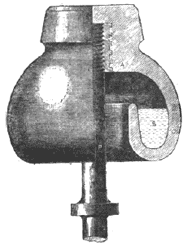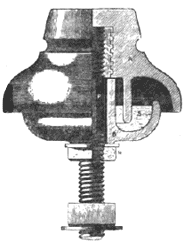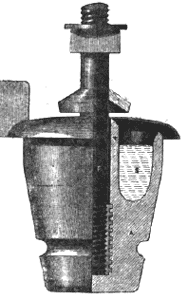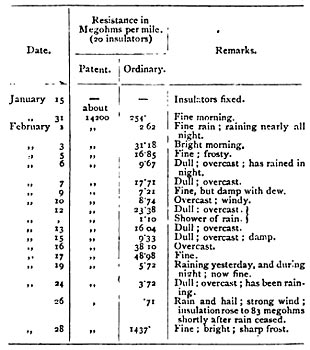[Trade Journal]
Publication: The Telegraphic Journal and Electrical Review
London, England
vol. 5, no. 113, p. 244-245, col. 1-2
JOHNSON AND PHILLIPS' PATENT
INSULATORS.
ALTHOUGH the production of an efficient form of insulator for aerial wires is a most interesting and important problem, the advance made in this branch of practical telegraphy has by no means been as great as could be wished.
The employment of a liquid repellant of moisture placed in a recess formed around the ordinary cup form of insulator was, we believe, attempted some years ago; but either through the imperfect way in which the experiment was made or in consequence of the utility of a very high state of insulation, not being so apparent as it is at the present day, when economy of battery power and the employment of the duplex and quadruplex systems of working are points of great importance, the idea was not carried into practice. Messrs. Johnson and Phillips, who have paid considerable attention to the production of an efficient form of insulator on the above principle, have so far succeeded as to obtain patterns which have proved efficient under conditions which would be fatal to those of the ordinary form.
Although these insulators require the test of continued use under conditions that exist in ordinary aerial telegraph lines, yet the success that has been obtained is so remarkable as to deserve notice. Figs, 1, 2, and 3, show forms of these insulators.
 |
| Fig. 1. |
Fig. 1. This insulator is fixed above its arm or support in the usual manner. The lower edge of the porcelain A is turned up inwards so as to form a chamber, shown at s, in which oil or some other insulating fluid is placed.
 |
| Fig. 2. |
Fig. 2. In this insulator the porcelain consists of two parts. A, the head, is firmly cemented to the bolt p, which passes freely through the second part B, containing the insulating fluid s. B is held in position by the nut x; when this nut is unscrewed B may be lowered so as to expose the oil chamber s to view for the purpose of examination or for the introduction of the oil.
In both cases the insulators are easily filled with the oil or other insulating fluid by means of a longnecked syringe.
 |
| Fig. 3. |
Fig. 3 shows how an ordinary porcelain insulator may have the insulating fluid principle applied to it. The cup-shaped space s is partly filled with the fluid, c is a dished metal cover resting upon the porcelain tube T. This cover is not fixed, but is free to rotate round the bolt P; a fan F, attached to this cover causes it to rotate from time to time by the action of the wind, the object being to break any spiders' webs or filaments which might cause a leakage from the surface of the insulator to the cover. An india-rubber ring w prevents the rain from entering the oil chamber by means of the hole in the cover through which the bolt passes; it also, when properly placed, prevents the cover c from being tilted up by the wind and touching the porcelain. This form of insulator is especially adapted to districts infested with spiders or other web-spinning insects.
The following tests taken on twenty of the patent insulators and on four ordinary white porcelain insulators with a porcelain tube round each bolt speak for themselves.
The loss obtained on the four ordinary insulators is multiplied by five, to make it comparable with the twenty patent insulators, which are assumed to represent a mile of line.
The tests were taken with eighty cells, and an astatic mirror galvanometer.
The absolutely uniform insulation shewn for the patent insulators, is not strictly correct, but the deflection obtained on them never being more than two divisions, it was impossible to detect small alterations in the insulation.
|
The above figures show the great effect which surface leakage has upon the insulation of an ordinary line; the test taken on February the 12th was very marked, when the insulation of the ordinary insulators fell from 23 megohms to 1.1 megohm in a few minutes after the rain commenced. On the 26th it was equally instructive to notice how the insulation rose, when, the rain and hail ceased, and the strong wind blowing at the time, dried the surface of the insulators; the change in this case also took place in a few minutes.
The rain on the 26th had cleaned the surface of the insulators, hence the high insulation obtained during the sharp frost on the 28th.
The tests were taken at about 7 a.m.
While all these changes were taking place in the ordinary insulators, it will be noticed that the high insulation given by the patent insulators, remained perfectly constant (as far as could be detected).
It should be noted that under the influence of frost the insulation still remained good, although it might have been expected that the coagulation of the oil would have prevented such a favourable result being obtained.

